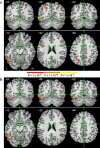Tuning of the human left fusiform gyrus to sublexical orthographic structure
- PMID: 16956773
- PMCID: PMC1634933
- DOI: 10.1016/j.neuroimage.2006.06.053
Tuning of the human left fusiform gyrus to sublexical orthographic structure
Abstract
Neuropsychological and neurophysiological evidence point to a role for the left fusiform gyrus in visual word recognition, but the specific nature of this role remains a topic of debate. The aim of this study was to measure the sensitivity of this region to sublexical orthographic structure. We measured blood oxygenation (BOLD) changes in the brain with functional magnetic resonance imaging while fluent readers of English viewed meaningless letter strings. The stimuli varied systematically in their approximation to English orthography, as measured by the probability of occurrence of letters and sequential letter pairs (bigrams) comprising the string. A whole-brain analysis showed a single region in the lateral left fusiform gyrus where BOLD signal increased with letter sequence probability; no other brain region showed this response pattern. The results suggest tuning of this cortical area to letter probabilities as a result of perceptual experience and provide a possible neural correlate for the 'word superiority effect' observed in letter perception research.
Figures




References
-
- Aguirre GK, Zarahn E, D'Esposito M. An area within human ventral cortex sensitive to “building” stimuli: evidence and implications. Neuron. 1998;21:373–383. - PubMed
-
- Alexander MP, Friedman RB, Loverso F, Fischer RS. Lesion localization of phonological agraphia. Brain Lang. 1992;43:83–95. - PubMed
-
- Baayen RH, Piepenbrock R, Gulikers L. The CELEX Lexical Database (CD-ROM) 2.5 Edition Linguistic Data Consortium, University of Pennsylvania; Philadelphia: 1995.
-
- Behrmann M, Plaut DC, Nelson J. A literature review and new data supporting an interactive activation account of letter-by-letter reading. In: Coltheart M, editor. Pure Alexia (Letter-by-Letter Reading) Psychology Press; Hove, UK: 1998. pp. 7–51. - PubMed
Publication types
MeSH terms
Substances
Grants and funding
LinkOut - more resources
Full Text Sources

